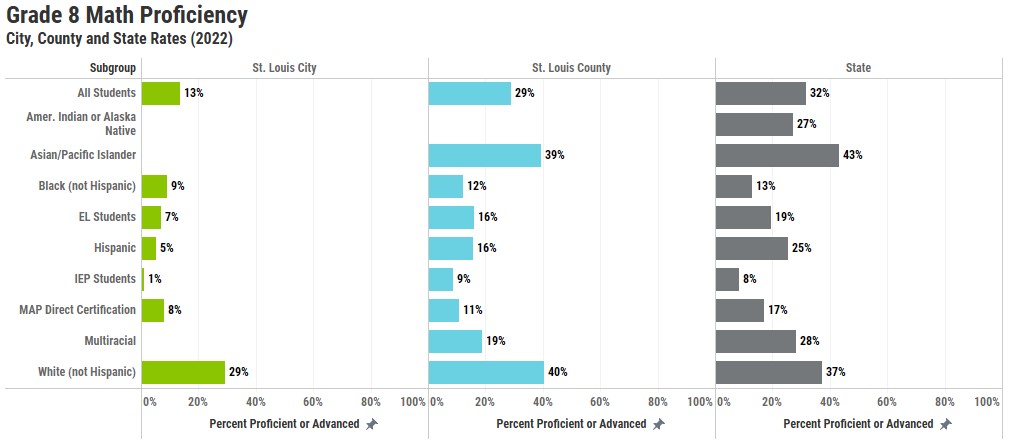8th Grade Math Proficiency
Milestones for Student Success
What it is
Eighth grade math proficiency is an indicator of whether a student will have access to or be prepared for higher-level math in high school.
Missouri monitors student progress in math through the Missouri Assessment Program (MAP), which tests all third through eighth graders each year on how well they’ve mastered concepts and skills.
Based on how well students perform on the assessment determines their performance level. Eighth graders who score proficient or advanced are considered to have mastered concepts such as number sense and operations; expressions, equations, and inequalities; functions; geometry and measurement; and data, analysis, and statistics.
They’ve also mastered skills such as working with radicals and integer exponents, understanding and applying the Pythagorean Theorem, and using functions to model relationships between quantities, among others.

Photo by Allison Shelley for EDUimages
Why it matters
Eighth grade is a particularly important year because students’ mastery of mathematical concepts and skills will determine which high school math courses will be available to them. And, therefore critical to setting students up for college and beyond.
- Eighth grade math proficiency is considered the “gatekeeper” to advanced math and science courses such as calculus and physics.
- Middle schoolers who meet certain math thresholds are more likely to finish high school prepared for college and careers, research shows.
- Given that high school math achievement predicts college readiness and early career success, eighth-grade math informs whether students are progressing toward postsecondary success.
What the data tell us
Thirty-two percent of Missouri eighth graders were proficient in math in the spring of 2022. This is up from 27% in 2021, according to results from the Missouri Assessment Program (MAP).
Eighth graders in St. Louis Public Schools and charter schools performed below the state rate but also improved proficiency from 9% in 2021 to 13% in 2022. Eighth graders in St. Louis County remained below the state rate at 29% in 2022. The eighth grade proficiency rate in the county fell below the state rate for the first time in over 10 years in 2021.
Considerable differences in competency exist within and between student groups.
- Nine percent of Black students in St. Louis City scored at grade level in math compared to 14% of Black students in St. Louis County, based on the MAP. This means that nine in 10 Black students across St. Louis are unprepared for math and science courses that would equip them for postsecondary and career success.
- A marked disparity exists between city and county students with individualized education plans (IEPs). The proficiency rate for all students with IEPs in St. Louis City was 1% compared to students with IEPs in St. Louis County at 10%.
- A significant disparity exists among students of different incomes. Higher-income students are at least three times more likely to be proficient than their lower-income peers in both St. Louis and St. Louis County.
What we’re learning
Cities such as Washington, D.C., Cleveland, Atlanta, and Charlotte, North Carolina have seen improvements in 8th-grade math.
Some strategies used in these and other fast-improving cities share commonalities, such as setting high academic standards, increasing teacher capacity, and strengthening accountability systems.
Cleveland, the fastest improving city in eighth grade math between 2009-2019, has stable and empowered leadership, accountability and transparency with student outcomes. It also uses a portfolio model within its district, which allows for charter schools to enter a performance compact with the traditional school district.
Elsewhere, Wake County has experimented with approaches to ensure more middle school students have advanced math opportunities prior to entering high school. Research suggests that early access to advanced math coursework, particularly taking Algebra I in 8th grade, can boost later math and reading achievement and, to some degree, help more students complete higher-level math coursework in high school, such as pre-calculus or calculus, which increases students’ readiness for college.
At the classroom level, research suggests five strategies for intervening and supporting elementary and middle school students struggling in math:
1. Universal screening to identify students at risk of struggling in mathematics and provide targeted interventions
2. Explicit and systematic instruction within an intervention
3. Instructing students to solve word problems based on common underlying structures
4. Supporting students with visual representations of mathematical ideas and ensuring interventionists are proficient visual communicators of mathematical ideas
5. Ensuring that instruction includes time for students to build skill in fluent retrieval of basic arithmetic facts
“
Early access to algebra has an effect beyond simple increased knowledge measures and, in fact, may “socialize” a student into taking more mathematics, regulating access both to advanced coursework and increased achievement in high school.
– Smith, J.B. (1996). Does an Extra Year Make Any Difference? The Impact of Early Access to Algebra on Long-Term Gains in Mathematics Attainment. Education Evaluation and Policy Analysis, 18(2), 141–153.
How to improve
- Every school in Missouri should utilize a highly rated math curriculum that aligns to college and career-ready standards and is user-friendly for students and educators.
- School leaders must support teachers to teach mathematics content with depth, coherence across grades and to other subjects, and rigor, so students achieve conceptual understanding, procedural skill and fluency, and effective application.
- New teacher pipelines should prioritize attracting and selecting math teacher candidates with STEM backgrounds. Research generally shows that math teachers across the country lack essential mathematics knowledge.
- Students and schools must be held to high standards for mathematics achievement. Struggling students and schools should have access to high-impact interventions such as intensive tutoring support and targeted teacher professional development.
Resource
The What Works Clearinghouse identifies seven distinct mathematics interventions with evidence of improving math performance among middle-grade students.



